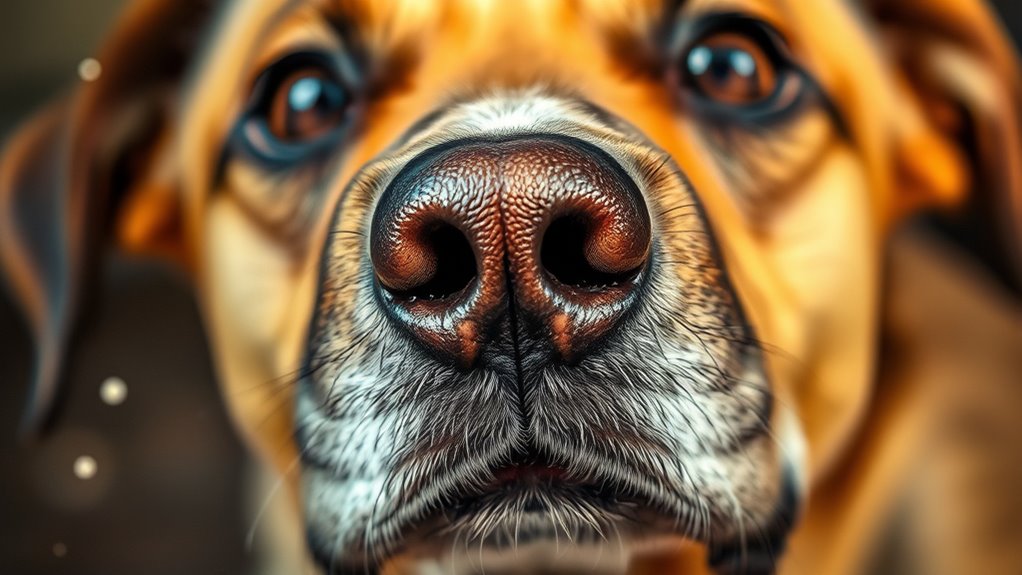To understand canine senses, recognize that dogs have extraordinary abilities, especially in smell and hearing. Their noses have up to 300 million scent receptors, allowing them to detect faint traces and build detailed environmental maps. Their hearing range extends far beyond humans, enabling them to pick up high-frequency sounds and subtle cues. By exploring how these senses work together, you’ll gain a deeper appreciation for what your dog perceives—and discover how their world is truly different from ours.
Key Takeaways
- Dogs perceive the world primarily through their highly developed senses of smell and hearing.
- A dog’s nose contains up to 300 million scent receptors, allowing detailed environmental detection.
- Their sense of smell is crucial for tracking, identifying individuals, and detecting environmental changes.
- Dogs can hear frequencies up to 60,000 Hz, enabling them to detect sounds beyond human hearing.
- The integration of olfactory and auditory senses provides dogs with a “superhuman” awareness of their surroundings.

Dogs perceive the world through senses that are far more acute than ours, allowing them to detect scents, sounds, and movements that we might miss. Their extraordinary senses are what make them incredible companions, capable of sensing things well beyond human perception. One of the most fascinating aspects of their sensory abilities is the complexity of their dog nose. Unlike ours, which are primarily used for breathing and taste, a dog’s nose is a highly specialized organ packed with millions of scent receptors—up to 300 million compared to our 5 million. This means that your dog can pick up an incredible array of smells simultaneously, from the faintest trace of a person’s perfume to the subtle scent trail left by another animal. Their nose doesn’t just detect odors; it analyzes and interprets them, giving your dog a detailed map of their environment that’s invisible to you. When you consider their dog nose, it’s clear that scent plays a *crucial* role in how dogs understand and navigate the world. Whether they’re tracking a scent trail, identifying familiar individuals, or detecting changes in their surroundings, your dog’s nose is central to their perception. The sense of smell in dogs is so powerful that it can be used in various detection roles, such as search-and-rescue or medical detection work.
Alongside their remarkable sense of smell, your dog’s hearing range is equally impressive. Dogs can hear frequencies much higher than those detectable by humans—up to 40,000 or even 60,000 Hz, compared to our 20,000 Hz. This expanded hearing range allows them to pick up on sounds that are entirely inaudible to us, such as distant sirens, the rustling of leaves, or the faint footsteps of someone approaching. Because of this, your dog can alert you to things you might never notice, making them excellent guardians and alert animals. Their ears are also highly mobile, enabling them to pinpoint the source of a sound with impressive accuracy. When you combine their acute sense of smell with their wide hearing range, you begin to understand why dogs are such exceptional detectors of their environment. They can pick up on subtle cues—both auditory and olfactory—that tell them what’s happening around them, even when you’re not aware of it. These senses work together, giving your dog an almost superhuman ability to perceive the world in ways that are both fascinating and *vital* to their role as companions and helpers. Understanding these senses helps you appreciate just how perceptive your dog truly is and deepens your bond with them.
Frequently Asked Questions
How Do Canine Senses Compare to Human Senses?
Your dog’s olfactory acuity far surpasses your visual perception, allowing them to detect scents you can’t even imagine. Their sense of smell is 40 times more powerful, making them exceptional at tracking. While humans rely more on vision, dogs excel in smell and hearing. You might see the world through sight, but your canine friend experiences it through an incredible sense of smell, making them excellent at tasks like search and rescue.
Can Dogs See in Complete Darkness?
Ever wonder if dogs see in complete darkness? While they have impressive night vision thanks to a reflective layer called the tapetum lucidum, they can’t see in total darkness. Their sensory limitations mean they rely on their heightened senses of smell and hearing more than their eyesight. So, while they see better than humans in low light, total darkness still leaves them in the dark.
How Sensitive Is a Dog’s Sense of Taste?
Your dog’s sense of taste is quite sensitive, but it’s not as advanced as their sense of smell. They rely more on scent than taste perception to explore their environment. Their taste buds can detect basic flavors like sweet, sour, salty, and bitter, but taste isn’t their primary sense for understanding food. Instead, their sensory sensitivity to smell helps them identify and evaluate what’s edible or safe.
Do Different Dog Breeds Have Varying Sensory Abilities?
Yes, different dog breeds have varying sensory abilities due to breed differences and sensory specialization. For example, bloodhounds excel at scent detection, while greyhounds have keen eyesight. You’ll notice that some breeds are more sensitive to sounds or touch, depending on their specific roles or traits. Understanding these differences helps you better appreciate each breed’s unique capabilities and how they’re specialized for certain tasks or environments.
Can Dogs Detect Medical Conditions Through Their Senses?
Did you know that dogs’ noses have up to 300 million scent receptors? They can indeed detect medical conditions through scent analysis. Your dog’s incredible sense of smell allows them to identify changes in your body, like low blood sugar or certain cancers, often before symptoms appear. By leveraging their natural abilities, dogs excel at medical detection, offering valuable assistance in early diagnosis and health monitoring.
Conclusion
Now that you understand your dog’s incredible senses, you can better connect and communicate with them. Remember, they see, hear, and smell the world in ways we can’t imagine, so it’s up to you to be patient and attentive. When you tune into their unique perceptions, you’ll find a bond that’s stronger than ever. Keep in mind, knowing your furry friend’s senses is the key to revealing a deeper companionship—it’s truly worth the effort.










